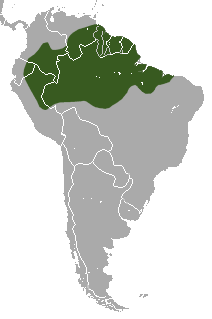Linnaeus's two-toed sloth
| Linnaeus's two-toed sloth | |
|---|---|
 |
|
| Scientific classification | |
| Kingdom: | Animalia |
| Phylum: | Chordata |
| Class: | Mammalia |
| Order: | Pilosa |
| Family: | Megalonychidae |
| Genus: | Choloepus |
| Species: | C. didactylus |
| Binomial name | |
|
Choloepus didactylus (Linnaeus, 1758) |
|
 |
|
| Linnaeus's two-toed sloth range | |
| Synonyms | |
|
Bradypus didactylus Linnaeus, 1758 |
|
Bradypus didactylus Linnaeus, 1758
Linnaeus's two-toed sloth (Choloepus didactylus), also known as the southern two-toed sloth, unau, or Linne's two-toed sloth is a species of sloth from South America, found in Venezuela, the Guyanas, Colombia, Ecuador, Peru, and Brazil north of the Amazon River. There is now evidence suggesting the species's range expands into Bolivia.
Sloths belong to the order Pilosa, which also includes anteaters. They belong to the super order Xenarthra, which includes the Cingulata. Xenarthra are edentate or toothless. They lack incisors and have a large reduction in number of teeth with only four to five sets remaining including canines.
Modern sloths are divided into two families based on the number of toes on their front feet, Megalonychidae and Bradypodidae. Linnaeus's two-toed sloth and Hoffmann's two-toed sloth (Choloepus hoffmanni) belong to the family Megalonychidae, which included extinct ground sloths.
Chloepus didactylus are larger than three-toed sloths. They have longer hair, bigger eyes, and their back and front legs are more equal in length. Their ears, hind feet and head is generally larger than Bradypodidae. They do however have a shorter tail. Their shoulder height, the height from the shoulder blade to the tips of the claw is longer than three-toed sloths, indicating longer arms.
The species has relatively few teeth; it has four to five sets including canines and lacks incisors. The teeth lack enamel, consisting only of two layers ever-growing dentin. Supernumerary teeth have occasionally been observed, but this has been reported in almost all mammalian orders.
...
Wikipedia

